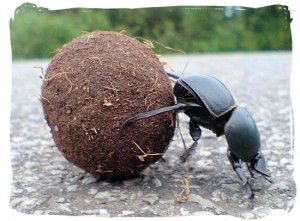Long before the advent of Google maps and hand-held GPS devices, humans had to rely on natural landmarks for navigation. Some cultures, such as Polynesian seafarers, are well known for their use of the stars to direct their movements. As it turns out, humans are not alone.
 A recent study found that African dung beetles use the Milky Way to orient themselves on clear nights, landing them in a small class of organisms, including humans, birds, and seals, that are confirmed to use the stars for navigation.
A recent study found that African dung beetles use the Milky Way to orient themselves on clear nights, landing them in a small class of organisms, including humans, birds, and seals, that are confirmed to use the stars for navigation.
Famous for sculpting spheres of scat, dung beetles compete fiercely with one another for food. Some individuals are lazier than others and attempt to steal dung balls from nearby beetles. In order to avoid being robbed, dung beetles must leave dung piles with their bounty as quickly as possible. Moving in a straight line away from the piles helps to ensure that they will avoid marauding competitors.
“Dung beetles are known to use celestial compass cues such as the sun, the moon, and the pattern of polarized light formed around these light sources to roll their balls of dung along straight paths,” Marie Dacke, lead author of the study, told Cell Press.
What was not known was how the beetles managed to move their dung balls along straight lines in the absence of major celestial markers. To find out, scientists attached “hats” to the beetles that effectively blocked out the night sky. Under such conditions, individuals wandered aimlessly.
Researchers also took dung beetles on a field trip to a planetarium where it was found that they could not follow a straight path without the aid of the Milky Way.
Scientists suspect that other organisms use the stars for navigation and hope that this study will encourage future research on the subject.
by Mike Vernon
Do you have a story for The Advocate? Email editor@corvallisadvocate.com

